Policies & action
NOTE: This update does not conduct a new rating of the UK’s climate targets, as the new government only entered power in July 2024. Instead, it describes the context inherited by the new government and highlights key areas for improvement. We will respond to any major announcements and provide an updated rating for the UK in 2025.
We rate the UK’s current policies until 2030 as “Insufficient”, when compared to modelled domestic pathways. The new government needs to take rapid action to develop and implement climate policies to reduce emissions. Our 1.5°C modelled domestic pathway is based on global least-cost mitigation and defines the minimum level of emissions reductions needed at home to be 1.5°C compatible. It should be taken as the floor, and not ceiling, for domestic ambition.
The UK’s stalled progress in climate policy development over recent years means that, without immediate and rapid change, the UK can no longer be considered a leader in global climate action. The “Insufficient” rating indicates that the UK’s climate policies and action in 2030 need substantial improvements to be consistent with limiting warming to 1.5°C. If all countries were to follow the UK’s approach, warming would reach over 2°C and up to 3°C. The new government has strongly indicated that it intends to address this policy shortfall, introducing new funding and delivery mechanisms to close the gap. The CAT will be tracking these policy developments and provide an updated assessment of the progress made in 2025.
Further information on how the CAT rates countries (against modelled domestic pathways and fair share) can be found here.
Policy overview
The new government has inherited a challenging policy context. The final years of the previous government were marked by chronic delays to key delivery mechanisms, rollbacks to other essential climate polices, and a clear lack of commitment to reducing emissions at the pace and scale needed to align with the Paris Agreement’s long-term temperature goal. As a result, in July 2024, only 24–32% of the emissions cuts needed to reach the UK’s climate targets were covered by credible policy (CCC, 2024).
The new government has highlighted that it wants to address this situation and close the implementation gap. It has already made a start on this, with some hopeful first signs including:
- In the power sector, where the government has set a target to achieve clean power by 2030. A decarbonised power sector by 2030 is a herculean endeavour, but would help unlock emissions cuts in other sectors, as clean electricity powers buildings, transport and industry. It would also demonstrate the viability of a clean power sector and rapid transition at scale, which could catalyse increased ambition in other countries and enable the UK to act as a global leader on power sector decarbonisation. To support this goal, the government has already lifted the de facto ban on onshore wind (DESNZ, 2024c) and secured record renewables capacity in the first auction after expanding the budget for renewables (DESNZ, 2024a, 2024d).
- In the buildings sector, the government has committed to double funding for energy efficiency improvements (Seddon, 2024), has signalled a willingness to enforce minimum efficiency standards in rental properties (DESNZ, 2024b) (a policy that was removed by the previous government), and has announced guidance on the next tranche of funding for retrofitting.
However, this will not be enough to close the implementation gap. Much more will be needed, including:
- Ramping up renewables. The government’s commitment to clean power needs to be backed by a laser-focus on delivery. The latest renewable auction delivered record levels of renewables, including 5 GW of offshore wind. But this is still not enough to achieve clean power by 2030 – more needs to be done. Grids and storage will also be key to the power sector transition.
- Accelerating electrification. Removing policy costs from electricity bills would help incentivise industrial electrification and ensure that heat pumps truly cut consumer bills. Specific policies to incentive industrial electrification are also needed, and planning barriers to heat pumps and electric vehicle charging points need to be removed.
- Reversing recent rollbacks. The previous government exempted 20% of houses from the fossil-fuelled boiler ban, and delayed the ban on petrol and diesel vehicle sales to 2035. These policy rollbacks should be reversed.
Power sector
Power in the UK is transforming rapidly. Having successfully completed the coal phase-out, the UK now stands before a challenge facing many governments worldwide: fossil gas and oil sources are decreasing while renewable deployments continue, but both are happening too slowly. To ensure the UK meets its international commitments and limit warming to 1.5ºC, the government must accelerate its efforts to decarbonise the power sector.
The UK’s power sector crossed a milestone in October 2024 when the last coal-fired power station shut down. Rapid growth in renewables has phased out coal without increasing demand for fossil gas generation. In 2023, almost half of the UK’s electricity came from renewables, with a third of generation from wind and solar alone.
The focus must now turn to phasing out fossil gas. The UK has a target of achieving clean power by 2030 – this is a laudable goal which would put the UK at the forefront of the global power sector transition and demonstrate the viability of a fully decarbonised power sector to all.
Coal
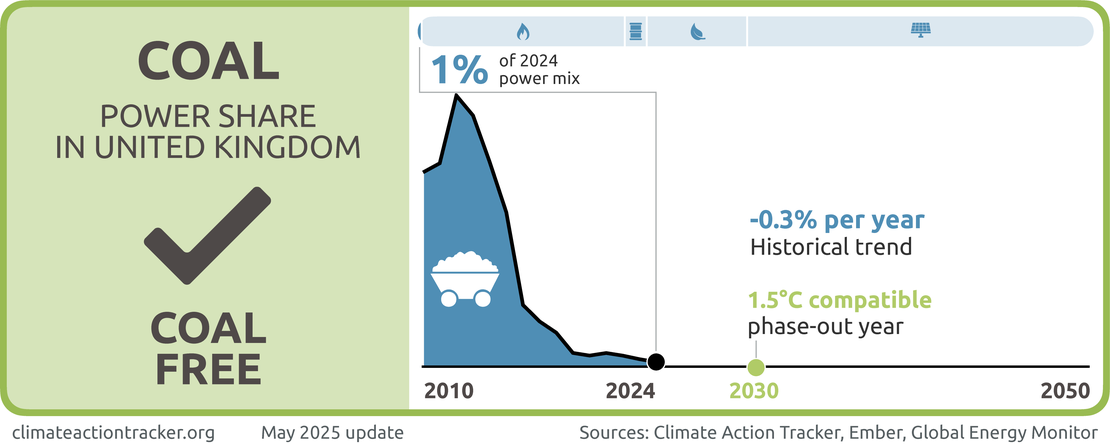
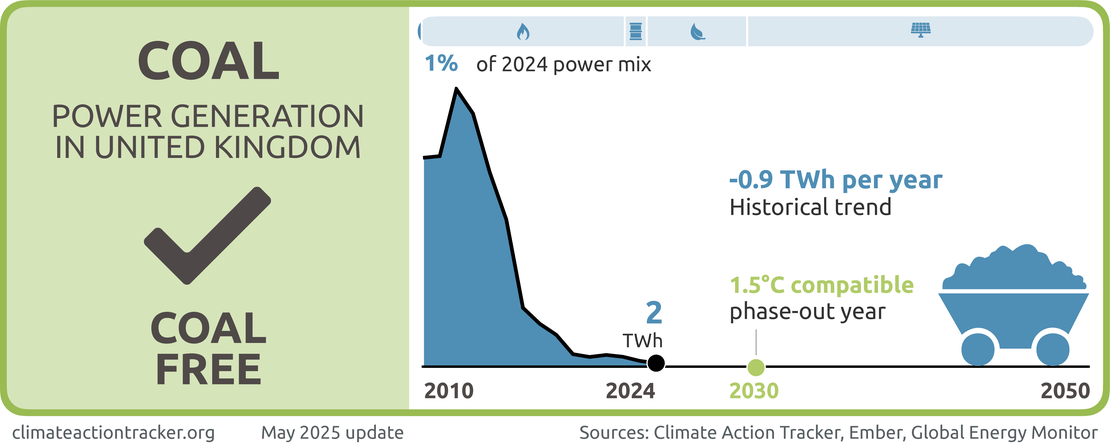
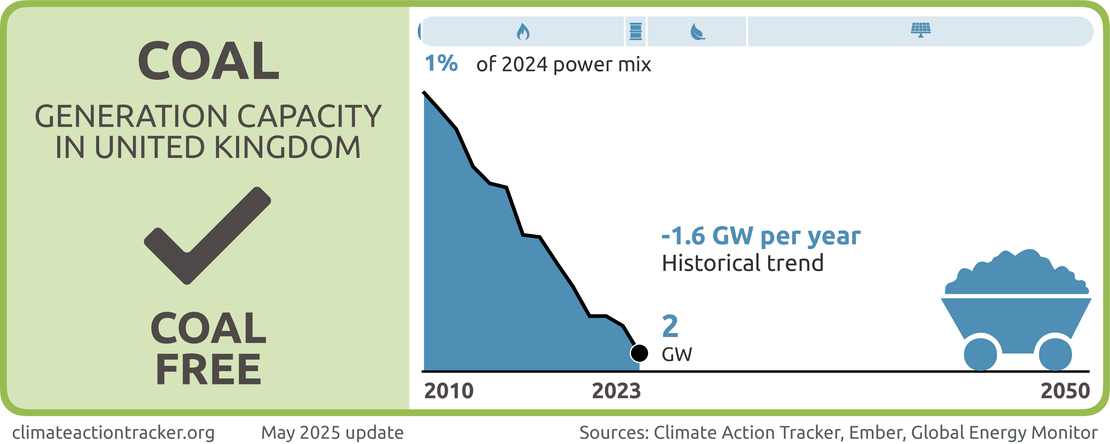
On the use of coal in the power sector, we evaluate the UK as “Coal free.” After many years of effort, the UK has been able to fully eliminate the use of coal in electricity generation, an important step on the way towards a fully decarbonised power sector.
The UK’s last coal-fired power station closed in October 2024, marking the end of an era. This historic moment puts the UK as a front-runner in the transition away from coal in the power sector, phasing out coal six years ahead of the 2030 deadline for developed countries (Climate Action Tracker, 2023).
The UK’s coal exit is one of its main climate policy success stories of the past decade. As recently as 2012, coal provided 40% of the UK electricity mix (Ember, 2023). The rapid phase-out of coal means that power sector emissions fell on average by 10% each year between 2012–2022 (BEIS & DESNZ, 2023).
Fossil gas and oil
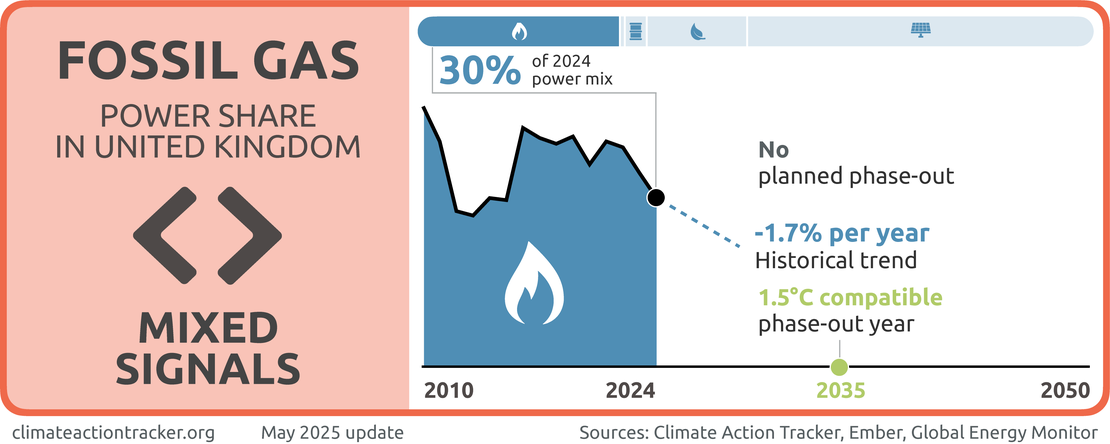
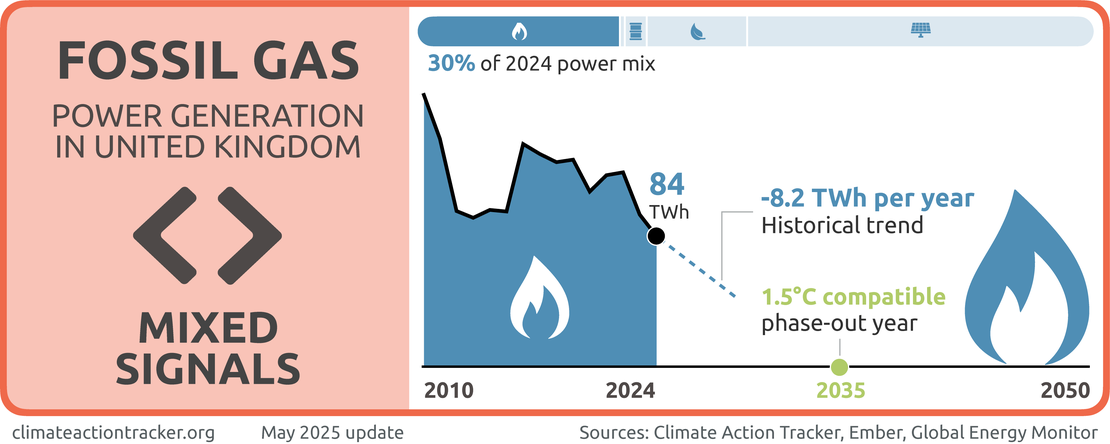

On the use of fossil gas and oil in the power sector, we evaluate the UK as sending “Mixed signals.” While both the share of energy produced by fossil gas and oil sources and their contributions to the total power supply have fallen over the last five years, gas remains a significant source of the UK’s electricity, providing nearly 30% in 2024. Plans to move away from fossil gas must be accelerated, and the UK must take care not to view fossil gas as an acceptable proxy for truly clean energy.
The new UK government has a target to achieve “clean power” by 2030. While it has not provided the exact definition of clean power, this ultimately must involve phasing out fossil gas in the power sector. The CAT has found that, to align with the Paris Agreement, the UK would need to reduce gas to 2–4% of the electricity mix by 2030 and cut this further by 2035 (Climate Action Tracker, 2023). The UK’s target for clean power appears broadly compatible with these benchmarks. Detailed modelling has shown that it is possible to push fossil gas out of the electricity system (CCC, 2023b; Ember, 2022).
It is unlikely that the UK will be able to fully phase out fossil gas in the electricity mix by 2030. However, it is possible to substantially cut gas demand. Detailed modelling highlights that the share of gas in the electricity system could fall to below 2% by 2030 without compromising security of supply (Ember, 2022). Keeping some of the fossil gas fleet as a “cold reserve” to provide very limited generation in periods of low renewable supply could help maintain energy security in the UK, while having a minimal impact on emissions. This fossil gas could then be fully phased out as alternative options to provide this back-up generation are deployed.
There is a wide range of options that can help balance a clean grid, including batteries, hydrogen, pumped storage, interconnectors and demand-side management. As such, fossil gas with CCS should play, at most, a minimal role in the power sector. Detailed modelling suggests that the UK could meet future electricity demand reliably in a grid dominated by wind and solar, with as little as 2.6 GW of fossil gas with CCS in the power sector in 2030, and only 0–5 GW by 2035 (CCC, 2023b; Ember, 2022).
Current CCS projects under development would be sufficient to reach this level. The UK should avoid embarking on a path of heavy reliance on fossil gas with CCS in the power sector, focussing instead on other measures to provide reliable zero-carbon electricity. Deploying turbines which can run on green hydrogen would be a key way to provide long-term flexible electricity generation without relying on CCS.
Renewables

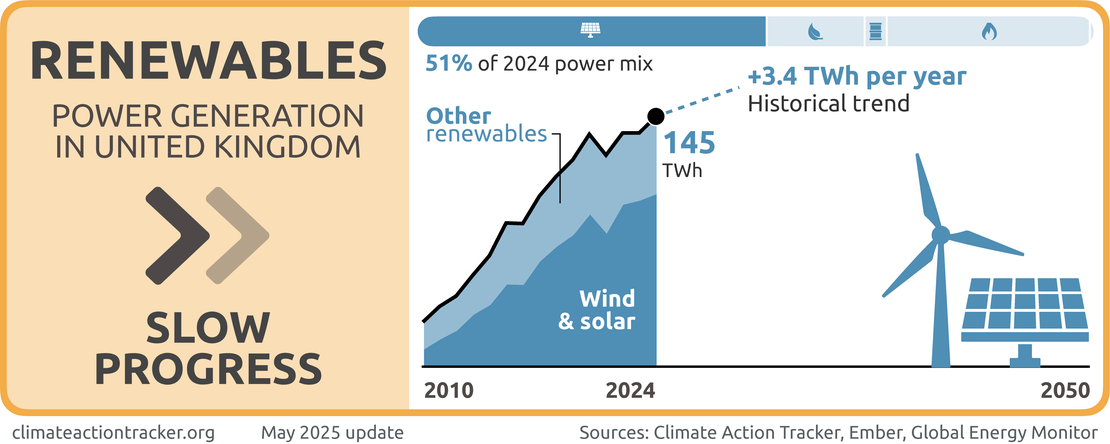
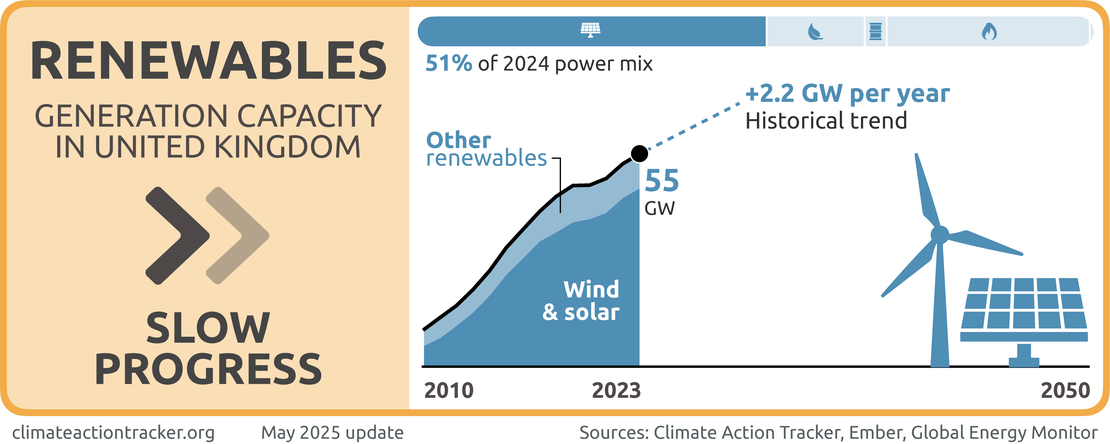
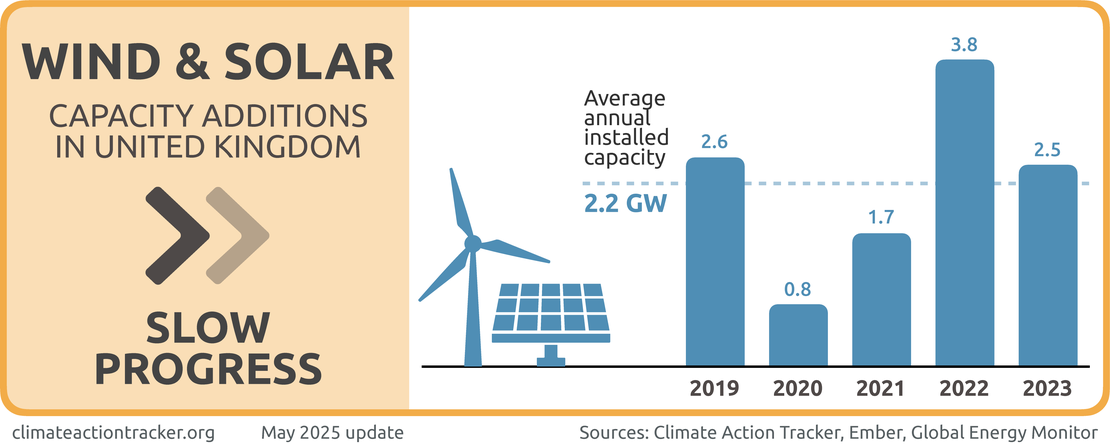
On the use of renewables in the power sector, we evaluate the UK as making “Slow progress.” For wind and solar sources, both their share of the energy mix and contributions to the total power supply have increased moderately over the last five years. While this is a positive trend, it needs to dramatically accelerate in order to keep the UK on a 1.5C compatible path to full decarbonisation.
The UK government is aiming to double onshore wind capacity, triple solar capacity and quadruple offshore wind capacity by 2030 to support its goal of clean power by 2030 (Parkinson, 2024). Turbocharging renewables will be crucial to aligning with 1.5ºC, with the CAT finding that in the UK, the share of renewables in the power sector should reach 84–93% by 2030 (Climate Action Tracker, 2023). The UK’s goal of clean power by 2030 would align with this, depending on the exact assumptions made about the role of nuclear power in the electricity system.
Getting sufficient renewables capacity connected to the grid and generating before 2030 will be a herculean challenge. The UK has a range of policies to support renewables deployment. The central policy is the Contract for Difference (CfD) scheme, which offers a guaranteed price to renewable generators over their lifetime, with the price set by reverse auctions. This has encouraged competition and innovation in the sector and driven large-scale investment and deployment. Wind capacity more than doubled in the past decade to 30 GW in 2023, while solar capacity grew from 3 GW in 2013 to 16 GW in 2022 (Ember, 2023).
However, as of July 2024, there were around 30 GW of offshore wind either in operation or in active development of some form (Ember, 2024). Given the lead time for offshore wind projects, this would mean that the 2024/2025 auctions would need to achieve over 20 GW of offshore wind deployment to keep the power sector on track for the 2030 goals (Ember, 2024). The 2024 auction achieved only 5 GW, putting offshore wind deployment in the UK significantly off track for the governments’ aims, and making the 2025 auction a critical policy milestone. Onshore wind and solar PV installation rates are also off track. The new government will need to move fast to try and address these issues and get renewables deployed at the pace and scale needed for its 100% clean power goal.
Industry
The UK’s Industrial Decarbonisation Strategy introduced by the previous government (UK Government, 2021a) aims to reduce industrial emissions by two-thirds below 2018 levels in 2035 and 90% by 2050. While emissions fell 3% in 2022 to 63 MtCO2e, they will need to fall much faster, by around 8% per year, to achieve the government’s climate targets (CCC, 2023a).
The strategy has a three-pronged approach: switching to low carbon fuels, efficiency gains, and carbon capture and storage (CCS). While some action is beginning to occur on fuel-switching, in particular in the electrification of steel, there remain significant gaps in the policies supporting resource efficiency in the industrial sector (CCC, 2024).
Fuel switching
In 2023, over 50% of industrial final energy was provided directly by fossil fuels (DESNZ, 2024c). This will need to be reduced substantially on the path to net zero. Two key options are the use of hydrogen, and direct electrification.
The Industrial Decarbonisation Strategy sets a target of 50 TWh of fossil fuels to be replaced by low-carbon alternatives by 2035 in the manufacturing sector (UK Government, 2021a). This is roughly a third of industrial fossil consumption in 2022. To support this target, the previous government introduced the Industrial Decarbonisation and Hydrogen Revenue Support (IDHRS) scheme.
This is similar to the CfD scheme in the power sector, providing financial support to cover the additional cost of low-carbon hydrogen production. GBP 140m was allocated to support fuel-switching over 2023–2024. This provides a business model to support industrial fuel-switching to hydrogen and is a positive step. There is also a GBP 240m Net Zero Hydrogen Fund (DESNZ, 2023). While these funds are to be welcomed, they are much smaller than the scale of funds being offered in Europe to support hydrogen deployment (Abnett, 2023).
Industrial electrification has taken a step forwards in the UK, with the agreement of a deal to transform the Tata steelworks from a coal-fired blast furnace to an electric arc furnace producing recycled steel (H. Thomas & Browne, 2024). In November 2023, a similar decision was announced for the remaining blast furnaces operated by British Steel, although the planned switch date of 2025 may be set back due to grid connection delays (Gill, 2024). This marks a transition away from coal in steelmaking which will reduce emissions.
However, there has not yet been sufficient planning on how to ensure a just transition which preserves jobs in local communities dependent on steelmaking. This is a critical gap that must be addressed. There is also a need to drive industrial electrification in a more systematic way, with electricity prices still too high when compared to fossil gas (CCC, 2024).
Carbon capture and storage
The previous government set an aim of delivering 6 MtCO2/yr of industrial CCS by 2030, and 9 MtCO2/yr by 2035. This represents around 17% of total abatement in the industrial sector by 2035 (CCC, 2023a). The new government has continued this commitment to CCS, pledging GBP 22 bn of funding to drive CCS projects over the next 25 years (UK Government, 2024). Relying too heavily on CCS to deliver emissions reductions in the industrial sector could be risky, as the majority of previous CCS projects have ended in failure (Abdulla et al., 2020). In many sectors, the role and value of CCS is also being eroded as the cost of renewables declines (Grant, Hawkes, Napp, et al., 2021). CCS should be prioritised for applications where there are few alternatives, such as cement production (E3G, 2023).
Fossil fuel supply
Achieving the UK’s climate targets will require strong and sustained reductions in oil and gas production, as well as improvements to the emissions intensity of any remaining extraction. Oil and gas demand will need to fall around 30% by 2030 to achieve the UK’s NDC (CCC, 2020). The CCC also suggested that the emissions associated with oil and gas extraction should fall 68% by 2030, through electrification of processes and addressing fugitive emissions (CCC, 2020).
The previous UK government moved in the opposite direction, continuing to support new oil and gas extraction in the North Sea, approving the Abigail, Jackdaw and Talbot fields (Oil and Gas Authority, 2023; A. Thomas, 2022; Tidman, 2022). New licensing rounds were held annually (UK Government, 2023a).
The incoming government has set a new direction, committing to end licensing for new oil and gas fields (Lempriere, 2024). This is a good start and should be welcomed. However, it does not address the substantial pipeline of projects which have already received exploration licenses and are either waiting for development consent or are already in production. There are thirteen such projects awaiting approval (Dunne, 2024).
The new government could strengthen its position on oil and gas by publicly committing to not approve this remaining pipeline of projects, and also set out a clear path to phasing out oil and gas production in the UK in line with the Paris Agreement goals, for example joining the Beyond Oil and Gas Alliance (BOGA).
Transport
The transport sector is the largest source of emissions in the UK, representing 29% of emissions in 2023 (DESNZ, 2024b). Central to decarbonising transport is ending the sale of fossil fuel cars and vans by 2030 and fossil fuelled heavy goods vehicles (HGVs) by 2035–40 (Department for Transport, 2021).
The policy context that the new UK government has inherited is mixed. On the one hand, the previous government confirmed the zero emissions vehicle (ZEV) mandate in 2023, which sets minimum EV sales targets for each vehicle manufacturer and will be a key delivery mechanism in scaling up EV sales (UK Government, 2023b). At the same time, the government pushed back the date of the sales ban on internal combustion engine cars from 2030 to 2035, sending a very mixed signal to the public and automotive industry. In 2023, the share of electric car sales in the UK failed to grow, flatlining at 16.5% and falling off track for the UK’s transition for the first time (SMMT, 2024). The share of electric van sales is growing much more slowly and is significantly off-track (CCC, 2024).
Key actions for the new government should include:
- Reinstating the 2030 ban on petrol and diesel vehicle sales
- Taking action to help accelerate EV rollout. This should include removing barriers for the installation of EV chargers and working with major van fleet operators to understand barriers to EV uptake.
Aviation
In 2022, the UK released its Jet Zero Strategy which aims to reduce emissions from this sector to net zero (Department for Transport, 2022). This aims for domestic aviation to reach net zero emissions by 2040, and total aviation emissions to reach net zero by 2050.
However, in this context, net zero does not mean eliminating the negative climate impacts of aviation, but rather allowing for a large-scale growth in emissions that would be compensated for via the UK emissions trading scheme, CORSIA and other offsetting mechanisms outside the aviation sector. The strategy also ignores the non-CO2 impact of aviation, which represents up to two-thirds of the sector’s overall climate impact (Lee et al., 2021).
The UK’s current strategy relies heavily on speculative technological innovation and carbon dioxide removal to enable a ‘net zero’ aviation sector, without addressing the elephant in the room – demand.
The previous government committed that sustainable aviation fuel (SAF) would provide 10% of overall fuel use by 2030, rising to 22% by 2040 (UK Department for Transport, 2024). This is five times the level included in the CCC’s Balanced Net Zero Pathway and would require an unprecedented scale-up of SAF production. The new government confirmed this commitment, and introduced a SAF mandate to drive this uptake (Department for Transport, 2024). There will also be a revenue certainty mechanism to provide confidence to investors seeking to build SAF plants to meet UK demand. However, SAF deployment remains very low globally and has consistently failed to meet expectations (Rutherford, 2022). Relying so heavily on this option therefore represents a major delivery risk.
The Jet Zero strategy also fails to address demand. The Government states that “the sector can achieve Jet Zero without the government needing to intervene directly to limit aviation growth” (Department for Transport, 2022), and envisages that passenger numbers could rise 70% from 2021 to 2050. This is in contrast to the CCC’s advice, which was that no net expansion in airport capacity should be permitted, and passenger growth should be 25% at most (CCC, 2020). Numerous airports are currently planning expansions or have received approval to expand in the past two years (AEF, 2022) which again could threaten the UK’s ability to achieve its climate targets. As yet, the new government has not provided any clear commitments that it will curb aviation demand, with the chancellor repeatedly mentioning aviation as a key engine of economic growth (Topham, 2024).
As a result, in 2050, the Jet Zero strategy expects that aviation will still be emitting around 19 MtCO2 per year, which will need to be compensated for by CO2 removal. Given the very limited potential for CO2 removal and uncertainties in the climate system, CO2 removal should be reserved to hedge against climate uncertainties and balance out truly hard-to-abate residual emissions (e.g. from agriculture), rather than to facilitate a stark increase in aviation emissions in one of the world’s wealthiest countries.
For more information on the need to align aviation and shipping emissions with the Paris Agreement, see the sectoral pages oninternational aviation and international shipping.
Buildings
Buildings were responsible for 20% of UK emissions in 2023 (DESNZ, 2024b). Emissions fell strongly in 2023 by 7.2% relative to 2022, due to reductions in gas demand (CCC, 2024). However, it remains unclear whether this was due to gas prices (which remain above the levels seen before the fossil gas energy crisis) or due to other drivers. Importantly, key indicators for tracking buildings decarbonisation, including the rate of heat pump installations and the rate of energy efficiency installations, are lagging far behind the level needed.
The number of heat pumps installed in 2023 increased only 4% from 2022 (CCC, 2024). The growth rate should be nearer 40–50% per year, if the number of annual installations is to reach 600,000–900,000 by 2030. Meanwhile the number of energy efficiency installations driven by government schemes fell in 2023, moving significantly off-track. This suggests that, without government action, the emissions reductions seen in 2023 will not be sustained into the future.
Priority actions for the new government should include:
- Introducing a comprehensive programme for decarbonising public sector buildings. Public buildings such as schools, hospitals and administrative buildings represent a low-hanging fruit which could deliver substantial emissions reductions quickly.
- Removing planning barriers to heat pumps. The previous Government proposed such changes which would make it easier to install heat pumps (DLUHC, 2024). The new government should implement these changes immediately.
- Re-introducing obligations for landlords to improve the energy efficiency of rented homes. The new government has committed to do this in its manifesto – it must now turn this ambition into action.
- Removing the exemption of 20% of houses from the fossil-fuel boiler installation phase-out. The previous government introduced this exemption, suggesting that it would save money. However, maintaining the gas distribution network for such a small set of households would likely increase, not reduce costs.
Agriculture
Agriculture was responsible for 12% of UK emissions in 2022 (DESNZ, 2024a). There has been essentially no progress made in agricultural decarbonisation over the past decade, with emissions in 2022 at the same level as in 2012.
In many places, the existing policy portfolio for agricultural decarbonisation is “too little, too late”. There is still no ban on the use of peat in gardening products, and plans to introduce methane-supressing feed products by 2030 are too late.
Key actions for the new government include:
- Introducing policies to hedge against the risk of delivery failure. The existing approach to agricultural decarbonisation has relied heavily on measures which are technological and voluntary in nature: this is a significant delivery risk. Productivity improvements on their own will not necessarily reduce emissions, with a risk that farmers simply increase herd numbers instead of freeing up land. Policies need to be developed to address these risks.
- Introducing measures to address dietary change and food waste prevention. The existing Government Food Strategy does not introduce measures to support and accelerate dietary shifts, despite the clear health benefits of doing so, and the evidence of consumer appetite for reduced meat consumption (Stewart et al., 2021; UK Government, 2022). The Food Strategy also only addressed food waste from large businesses, despite the majority of food waste occurring at the household, farm and supply-chain stages.
The UK has one of the lowest levels of forest cover in Europe, at 13% (Forest Research, 2023). The UK has set a target of planting 30,000 ha/yr of new woodland by 2025, which is aligned with the CCC’s recommendations. However, planting rates in 2023 were under half of this level (Forest Research, 2023).
It is essential that the new government takes action to accelerate tree planting. This will require new delivery mechanisms, complete with the required rates of funding. In particular, there is a need to provide clear long-term funding, and to streamline processes in order to draw in private capital.
Progress in protecting and restoring degraded peatland is also significantly off track. The Climate Change Committee recommends that over 60,000 ha/yr of peatland is restored from 2025 onwards. But in 2022/23, only 13,000 ha were restored – less than a fifth of recommended levels (CCC, 2023a). Key policy gaps include restrictions on the burning of peatland, as much peatland remains unprotected by current legislation, and a faster phase-out for peat in horticultural products, as the sale of peat will currently only be fully banned by 2030 (The Wildlife Trusts, 2023).
Methane
14% of the UK’s total emissions in 2022 came from methane (DESNZ, 2024a), with 80% of these emissions coming from agriculture and waste. The UK is also a signatory to the Global Methane Pledge, which sets a target of reducing methane emissions by 30% over 2020–2030. However, to date methane emission reductions are not happening fast enough in the UK. On average, methane emissions fell 0.9 MtCO2e/yr over 2015–2022. This would need to double to over 1.9 Mt CO2e/yr to reach the current 2030 targets.
Key actions for the government to take include:
- Publishing plans to capture methane emissions from landfill sites, as well as improving the monitoring of landfill emissions.
- Develop plans to reduce methane emissions from agriculture. This should include accelerating the deployment of methane-supressing feed products within the industry, as well as promoting measures to cut demand for meat and dairy.
- Track, monitor and transparently report on the UK’s progress towards the Global Methane Pledge.
Further analysis
Latest publications
Stay informed
Subscribe to our newsletter







